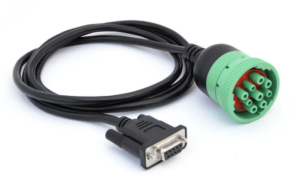
Fig.: J1939 connection technology
J1939 is mainly used in the automotive sector to network components in order to reduce the wiring effort. It is based on the CAN bus as a transmission method. J1939 was approved by the international Society of Automotive Engineers (SAE) defines and works on the physical layer with CAN high-speed with 1 MBit/s. In the marine sector, the CAN speed was reduced to 250kBit/s to enable a certain degree of compatibility with NMEA2000. The J1939 is a multi-master system with decentralized network management without channel-based communication. It supports up to 254 logical nodes and 30 physical control units per segment. The information is described as parameters (signals) and summarized on 4 memory pages (data page) in parameter groups (PGs). Each parameter group can be identified by a unique number, the Parameter Group Number (PGN). Irrespective of this, each signal is assigned a unique SPN (Suspect Parameter Number). Most of the communication takes place cyclically and can be received by all control units without an explicit request for data (broadcast). In addition, the parameter groups are optimized to a length of 8 data bytes. This enables the CAN protocol to be used very efficiently. Certain information such as B. configuration data or diagnostic data can also be exchanged exclusively between two control units (peer-to-peer). The specification of the communication, broadcast or peer-to-peer, is a property of the parameter group used.
The data organization is similar to NMEA2000 but not compatible with it. In the marine sector, J1939 is mainly used for modern drives. Due to the incompatibility with NMEA2000, gateways are required that enable information to be exchanged between the networks.
open-source
For J1939 there are various open source implementations via OBD-2 in the automotive sector, which enable access to the CAN bus. In the marine realm, there's a DIY project to one J1939/NMEA2000 gateway for a Volvo Penta inboard diesel.